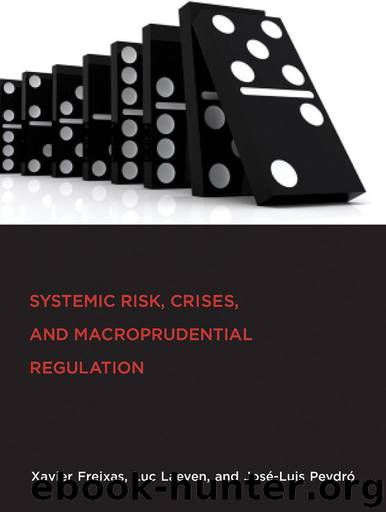Systemic Risk, Crises, and Macroprudential Regulation (The MIT Press) by Peydró José-Luis & Laeven Luc & Freixas Xavier

Author:Peydró, José-Luis & Laeven, Luc & Freixas, Xavier
Language: eng
Format: epub
Publisher: The MIT Press
Published: 2015-07-02T16:00:00+00:00
The One-Factor Merton Model A second point to emphasize is that if the risks of individual loans are independently distributed, the law of large numbers assures that the probability of bankruptcy tends toward zero when the number of loans tends to infinity, provided that the expected return on the loan is larger than the average cost of capital, that is, that banks are profitable ventures. This means that in such a world of independently distributed losses, the expected losses are covered by the interest rate charged on the loan.
This academic exercise allows us to define capital as differing from provisions. Indeed risks related to the independent risks of each loan, the expected losses, should be covered by the interest rate charged on the loan and accounted for as provisions. Capital should, instead, be defined as the amount to cover unexpected correlated risks.5
The independently distributed losses case implies that any realistic model of banks’ risks should be based on common factors simultaneously affecting all loans. The Basel approach takes the simplest possible model when it postulates the existence of a single (macroeconomic) factor that, as a first approximation, could be thought of as GDP growth. This is the rationale for having banks’ capital requirements that constitutes a buffer against the risk in this single systemic factor and is different from provisions.
In a world of specialized banks there is no unique measure of risk for each asset, as the portfolios the banks hold are different and have sector-specific risk. The risk of a specific Irish mortgage for an Irish bank that has 60 percent of its portfolio invested in this type of loan is therefore higher than for a German bank that has 2 percent of its portfolio invested in Irish mortgages. So the single-factor model cannot take this feature into account. Finally, notice that the single-factor model is an approximation. If there were several macroeconomic factors, the risk weights for each financial product would depend on the proportion of the different macroeconomic factors a bank portfolio embodies (Gordy 2003).
Download
This site does not store any files on its server. We only index and link to content provided by other sites. Please contact the content providers to delete copyright contents if any and email us, we'll remove relevant links or contents immediately.
International Integration of the Brazilian Economy by Elias C. Grivoyannis(74427)
The Radium Girls by Kate Moore(11616)
Turbulence by E. J. Noyes(7694)
Nudge - Improving Decisions about Health, Wealth, and Happiness by Thaler Sunstein(7238)
The Black Swan by Nassim Nicholas Taleb(6761)
Rich Dad Poor Dad by Robert T. Kiyosaki(6173)
Pioneering Portfolio Management by David F. Swensen(6074)
Man-made Catastrophes and Risk Information Concealment by Dmitry Chernov & Didier Sornette(5643)
Zero to One by Peter Thiel(5487)
Secrecy World by Jake Bernstein(4387)
Millionaire: The Philanderer, Gambler, and Duelist Who Invented Modern Finance by Janet Gleeson(4089)
The Age of Surveillance Capitalism by Shoshana Zuboff(3980)
Skin in the Game by Nassim Nicholas Taleb(3965)
The Money Culture by Michael Lewis(3842)
Bullshit Jobs by David Graeber(3826)
Skin in the Game: Hidden Asymmetries in Daily Life by Nassim Nicholas Taleb(3720)
The Dhandho Investor by Mohnish Pabrai(3560)
The Wisdom of Finance by Mihir Desai(3523)
Blockchain Basics by Daniel Drescher(3326)
